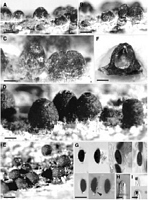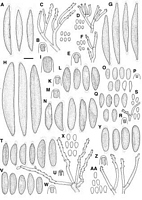|
 Rosellinia victoriae Rosellinia victoriae
BiostatusPresent in region - Indigenous. Non endemic
Images (click to enlarge)
Caption: Fig. 29 Rosellinia victoriae. A-E, Stromata showing white subiculum; F, Vertical section of
stroma; G, Ascospores, the two to the right in 1st row showing germ slit, others cell | 
Caption: Fig. 8 A-D, Rosellinia arcuata, PDD 41969: A, Ascospores; B, Ascus apical ring; C,
Conidiophores and conidia on the host; D, Conidiophores and conidia on OA; E-G, R.
freycinetiae, PDD 20580: E, Ascus a |
Article: Petrini, L.E. (2003). Rosellinia and related genera in New Zealand. New Zealand Journal of Botany 41(1): 71-138 (http://www.rsnz.org/publish/abstracts.php).
Description: Subiculum evanescent, white to cream, felty. Stromata (500)525 ± 35(575) µm high, (550)585
± 22(600) µm wide (n = 5), conical, semiglobose to globose with broadly rounded top, black,
crowded. Ostioles finely papillate or not differentiated. Ectostroma 50 µm thick, black.
Entostroma not seen. Perithecia remaining attached to the stroma. Ascus apical ring 2.8-3.8
µm high, upper width 2.4- 2.8 µm, lower width 1.9-2.8 µm (n = 5), J+, blue. Ascospores
(11.5)12.9 ± 0.8(14.4) mm long, (5.3)5.7 ± 0.3(6.7) µm wide (n = 30), inequilaterally
ellipsoidal, dark brown, with straight germ slit extending the whole spore length, occasionally
one extremity with a 1 x 1 µm large, semiglobose, cellular appendage. Conidia 5-6 x 3 µm.
ANAMORPH: Geniculosporium.
Habitat: HOST: Metrosideros robusta.
MATRIX: Decorticated, heavily decomposed wood.
Notes: NOTES: Rosellinia victoriae is characterised by a white to cream, evanescent subiculum, by
small, almost globose stromata with poorly developed ostioles, and dark brown ascospores
bearing a cellular appendage that is visible at maturity. Examination of the type material from
S revealed no differences between the two specimens. Therefore, the name R. victoriae can be
applied also to the New Zealand collection.
Rosellinia victoriae differs from R. rhopalostilicola by the stroma shape, poorly expressed
ostioles, ascospores with a cellular appendage and larger conidia.
|